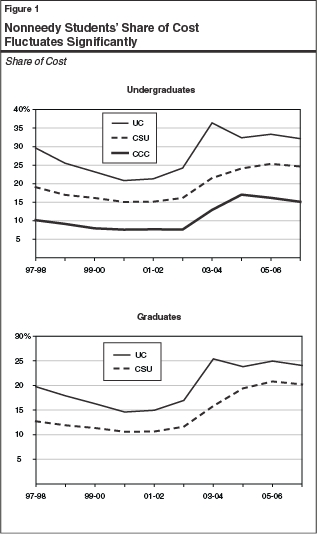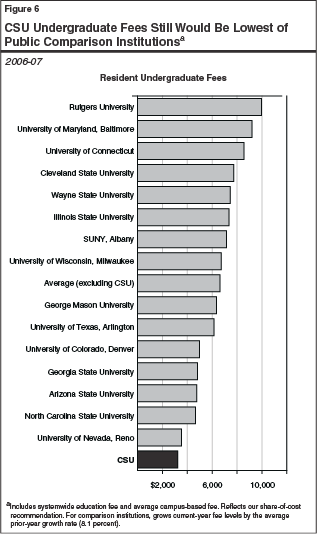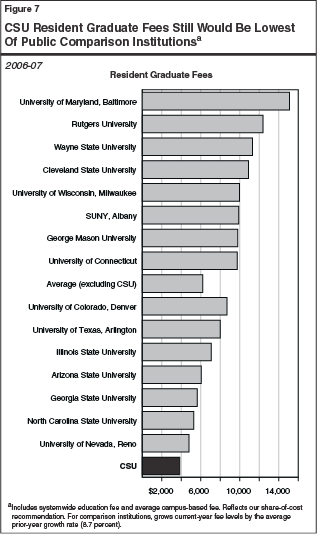Analysis of the 2006-07 Budget BillLegislative Analyst's Office
|
Currently, the state has no student fee policy for the University of California (UC), Hastings College of the Law (Hastings), California State University (CSU), or California Community Colleges (CCC). Lacking a long-term approach to setting fees, the state has tended to make fee decisions based almost entirely on its fiscal condition-raising fees in bad fiscal times and lowering them in good fiscal times. In an attempt to address this volatility, the administration established written agreements with the segments that called for modest fee increases annually through 2010-11. Consistent with these agreements, the UC Regents, Hastings Directors, and CSU Trustees approved fee increases for 2006-07 of 8 percent for undergraduates and 10 percent for graduate students. The administration now proposes that those fee increases be revoked and student fees be maintained at their current-year levels. (The administration also proposes that CCC fees remain unchanged.) In a related proposal, the Governor’s budget provides the higher education segments with an unallocated $149 million General Fund augmentation intended to substitute for the foregone fee revenue. (Of this amount, $75 million is provided to UC, $1.4 million to Hastings, $54 million to CSU, and $19 million [Proposition 98] to CCC.) We have concerns with both the proposed fee levels and the proposed “fee buyout.”
Below, we first describe the problems associated with not having a fee policy, discuss the benefits of a share-of-cost fee policy, and explain our recommendation to hold students’ share of cost constant from 2005-06 to 2006-07. We then compare various 2006-07 fee proposals. Toward the end of the piece, we discuss the Governor’s proposed fee buyout.
Over the last ten years, fee levels have fluctuated significantly, as have students’ expected contributions toward education costs. As shown in Figure 1, UC undergraduates’ share of their education costs

over this period has been as low as 21 percent and as high as 36 percent. Following the same trend, UC graduate students’ share of cost has ranged from 15 percent to 25 percent. At CSU and CCC, students’ share of cost has been equally volatile. Undergraduates’ share of cost at CSU has ranged from 15 percent to 25 percent, and graduate students’ share of cost has ranged from 11 percent to 21 percent. At CCC, students’ share of cost has been as low as 8 percent and as high as 17 percent.
Lack of Fee Policy Has Resulted in Inconsistent Treatment of Student Groups. In general, financially needy students of traditional college age are not required to pay education fees to attend public higher education in California. (These fees are covered through a variety of financial aid programs, which we briefly describe in the box. In that box, we also describe aid programs designed for students who are not of traditional college age.) Therefore, the state intends for only nonneedy students to pay a portion of their direct education costs. The lack of a fee policy generates considerable volatility and disparity among nonneedy students. As reflected in Figure 1, nonneedy student groups bear very different shares of cost depending on the state’s fiscal fortunes during the years they attend college. The resulting annual changes in fee levels clearly are not gradual, moderate, or predictable-despite these principles being embedded in virtually every student fee policy the Legislature has considered over the last decade.
State Financial Aid Programs Intended to Ensure AccessThe Legislature has established a number of financial aid programs intended to ensure that the state’s financially needy students have access to public higher education. Given these programs cover education fees for most financially needy students of traditional college age and many older students, the state’s fee decisions largely affect only nonneedy students and the share of cost they bear. For community college students, one of the major financial aid programs is the Board of Governors (BOG) fee waiver program. Under this program, all students who have even one dollar of financial need (as defined by federal guidelines) are eligible to have their fees entirely waived. There are no grade point average (GPA) or age requirements and family incomes can be relatively high. For example, a dependent student in a family of four with income as high as $80,000 could still receive a fee waiver. Currently about 42 percent of all full-time equivalent students receive BOG waivers. Financially needy undergraduate students at the University of California (UC) and the California State University (CSU) (as well as private colleges and California Community College) are generally eligible for a Cal Grant, which pays education fees and in some cases provides a living stipend. Students who have recently graduated from high school and young adults who are transferring from a community college to a four-year college generally are entitled to these grants (as long as they meet income and GPA requirements). Older students who are not eligible for entitlement awards compete for a fixed number of competitive Cal Grants. Currently, these older students are among the most likely not to be served by the state’s financial aid programs. (The Cal Grant program is expressly designed to give priority to students of traditional college age.) Many students, however, who are not awarded a Cal Grant have been able to receive institutional aid at UC and CSU. |
Share-of-Cost Fee Policy Has Many Benefits. A share-of-cost fee policy provides both an underlying rationale for fee levels and a simple mechanism for annually adjusting them. In doing so, it provides clarity, ensures consistency, fosters shared responsibility, and strengthens accountability. It provides clarity by establishing an expected contribution from all nonneedy students, regardless of when they enter college. It promotes consistency by routinely adjusting fee levels such that nonneedy students pay the same share of cost over time. It also recognizes that college is a partnership between students and the general public-expecting both to contribute to its costs and intending for both to benefit from its activities. Lastly, a share-of-cost policy ensures that students and the university share the cost of any new program or program enhancement, thereby providing a strong incentive for students to hold their campuses accountable for making quality investments at reasonable cost.
For 2006-07, we recommend the Legislature at least maintain nonneedy students’ share of cost at the current-year level. Holding this share constant would entail modest fee increases of 3.5 percent at the University of California (UC), 3.0 percent at the California State University (CSU), and 7.0 percent at the California Community College (CCC). For a full-time undergraduate, this equates to an annual increase of $215 at UC, $76 at CSU, and $55 at CCC. These increases would generate $84 million in net new fee revenue. (Of this fee revenue, $35 million is generated at UC, and $1 million at Hastings, $24 million at CSU, and $24 million at CCC.)
As indicated above, the Governor’s budget proposes no fee increases for resident students attending UC, Hastings, CSU, and CCC. At the same time, the Governor’s budget proposes various General Fund augmentations that would drive up the per student cost of education at all three segments and Hastings. Without fee increases, this results in nonneedy students’ share of cost falling (and the general taxpayers’ share increasing) between 2005-06 and 2006-07.
At a minimum, we recommend the Legislature maintain nonneedy students’ share of cost at their current-year levels (shown in Figure 2). This would entail modest fee increases of 3.5 percent at UC, 4.5 percent at Hastings, 3.0 percent at CSU, and 7.0 percent at CCC. The fee increases reflect both the effect of inflation and additional spending on education proposed in the Governor’s budget. Maintaining students’ share of cost at their current-year levels both would promote consistency among student cohorts and adhere to the broadly agreed-upon principles that fee increases should be gradual, moderate, and predictable. It also would reduce the need for steep fee increases in the future.
|
|
|||
|
Figure 2 Nonneedy Students’ Share of Cost |
|||
|
2005-06 |
|||
|
|
Average Cost of Education |
Systemwide |
Fees as a Share of Cost |
|
UC undergraduates |
$18,415 |
$6,141 |
33% |
|
UC graduate students |
27,622 |
6,897 |
25 |
|
CSU undergraduates |
9,932 |
2,520 |
25 |
|
CSU graduate students |
14,899 |
3,102 |
21 |
|
CCC students |
4,823 |
780 |
16 |
|
|
|||
Fees Would Be Lower Than Those Anticipated by Students and the Segments. Figure 3 and Figure 4 compare (1) the administration’s 2006-07 fee proposals, (2) our fee recommendations, and (3) the fee levels adopted last fall by the segments’ governing boards. The figures show that our recommended 2006-07 fee levels, while higher than those proposed by the Governor, are lower than those the segments have approved.
|
|
|||||||
|
Figure 3 Comparing 2006-07 |
|||||||
|
(Systemwide Education Fees for Full-Time Resident Students) |
|||||||
|
|
Governora |
|
LAOb |
|
Regents/Trusteesc |
||
|
|
Fee |
|
Fee |
Percent Increase |
|
Fee |
Percent Increase |
|
UC undergraduates |
$6,141 |
|
$6,356 |
3.5% |
|
$6,633 |
8% |
|
UC graduate students |
6,897 |
|
7,138 |
3.5 |
|
7,587 |
10 |
|
CSU undergraduates |
2,520 |
|
2,596 |
3.0 |
|
2,724 |
8 |
|
CSU graduate students |
3,102 |
|
3,195 |
3.0 |
|
3,414 |
10 |
|
CCC students |
780 |
|
835 |
7.0 |
|
— |
— |
|
|
|||||||
|
a Maintains fees at 2005-06 levels. |
|||||||
|
b Reflects our recommendation to maintain nonneedy students' share of cost at the current-year level. |
|||||||
|
c Reflects fee levels adopted by the boards at their fall 2005 budget meetings. |
|||||||
|
|
|||||||
|
|
|||||||
|
Figure 4 Comparing 2006-07 Professional School Fee Proposals |
|||||||
|
(Systemwide Education Fees for Full-Time Resident Students) |
|||||||
|
|
Governora |
|
LAOb |
|
Regents/ Directorsc |
||
|
|
Fee |
|
Fee |
Percent Increase |
|
Fee |
Percent Increase |
|
University of California |
|
|
|
|
|
|
|
|
Veterinary Medicine |
$18,024 |
|
$18,655 |
3.5% |
|
$18,926 |
5.0% |
|
Dentistryd |
21,949 |
|
22,717 |
3.5 |
|
23,048 |
5.0 |
|
Business/Managementd |
22,966 |
|
23,769 |
3.5 |
|
24,509 |
6.7 |
|
Lawd |
22,816 |
|
23,614 |
3.5 |
|
24,741 |
8.4 |
|
Medicine |
20,582 |
|
21,302 |
3.5 |
|
21,612 |
5.0 |
|
Optometry |
16,684 |
|
17,268 |
3.5 |
|
17,519 |
5.0 |
|
Pharmacy |
18,240 |
|
18,878 |
3.5 |
|
19,153 |
5.0 |
|
Nursing |
10,360 |
|
10,723 |
3.5 |
|
10,879 |
5.0 |
|
Theater/Film |
13,101 |
|
13,560 |
3.5 |
|
13,757 |
5.0 |
|
Public Health |
10,897 |
|
11,278 |
3.5 |
|
11,442 |
5.0 |
|
Public Policy/International |
10,897 |
|
11,278 |
3.5 |
|
11,442 |
5.0 |
|
Hastings College of the Law |
19,725 |
|
20,613 |
4.5 |
|
21,303 |
8.0 |
|
|
|||||||
|
a Reflects 2005-06 fee levels. |
|||||||
|
b Reflects our recommendation to maintain nonneedy students' share of cost at the current-year level. |
|||||||
|
c Reflects fee levels adopted by the boards at their fall 2005 meetings. |
|||||||
|
d Reflects midpoint of fee levels, which vary by campus. |
|||||||
|
|
|||||||
Fees Would Remain Very Low Compared to Similar Institutions. Even with the modest fee increases that we recommend, California’s fees would remain relatively low. As Figure 5 shows, assuming a 3.5 percent fee increase at UC in 2006-07, resident undergraduate fees very likely would remain the second lowest of UC’s public comparison institutions. Graduate fees very likely would remain the lowest. Assuming a 3 percent fee increase at CSU, resident undergraduate and graduate fees very likely would remain the lowest of CSU’s public comparison institutions (as shown in Figure 6 and Figure 7). Similarly, assuming a 7 percent fee increase at CCC, fees very likely still would be by far the lowest in the nation and less than one-third the national average.



Additional Fee Revenue Would Be Generated. By maintaining the relatively modest share of cost for nonneedy students at the three segments, fee revenue is generated from those with the ability to pay. Our recommended fee levels would generate $103 million in gross new fee revenue.
Financially Needy Students Would Be Protected From Fee Increases. The state has various financial aid programs that provide grants or waivers that cover education fees for financially needy students. Consistent with these practices, we recommend setting aside $19 million from the new fee revenue to fully cover the fee increases for existing as well as new financially needy students. Consistent with historical practice, we recommend covering the fee increases for undergraduates via the Cal Grant program and, for graduate students, covering them via the segments’ institutional aid programs (given the absence of a statewide program).
We recommend the Legislature reject the Governor’s “fee buyout” proposal because it distorts budgeting and creates the wrong incentives. Rather than provide a fee buyout, we recommend the Legislature provide the segments sufficient funding to meet identified needs.
The Governor’s budget provides the segments a large General Fund augmentation ($149 million) linked to a “fee buyout.” Specifically, $75 million is provided to UC, $1.4 million to Hastings, $54 million to CSU, and $19 million (Proposition 98) to CCC. In calculating the buyout, the Governor’s budget assumes the segments would have raised fees between 5 percent (for community college students) and 10 percent (for graduate students). It then provides General Fund support to offset the hypothetically foregone fee revenue. We recommend rejecting this fee buyout proposal because it distorts budgeting and creates the wrong incentives.
Fee Buyout Distorts Budgeting. The Governor’s budget bases a large General Fund augmentation on segment-approved fee increases. Linking the monies in this way tells the Legislature nothing about whether the funding is needed or how it will be spent. We believe the budget should be built in a more rational way. We recommend the Legislature first determine the segments’ overall budget needs. For example, as we discuss earlier in the higher education priorities write-up, the Legislature should first consider basic cost increases and enrollment growth. Once budget needs have been identified, the Legislature then can decide how to share any new costs between the state and students. In the above section, we recommend at least maintaining students’ share of cost at their current-year levels. To the extent the budget increases spending per student, maintaining students’ share of cost would entail modest fee increases and an associated increase in student fee revenue as well as additional financial aid. With this type of process, there is never a need to consider fee buyouts.
Fee Buyout Creates Wrong Incentives. Because the Governor’s fee buyout approach begins with fee increases disconnected from budget needs, it creates perverse incentives for the segments to build inflated budgets. For example, under the Governor’s approach, the segments could have proposed 30 percent fee increases (as occurred in 2003-04), which would have “required” a fee buyout of $584 million. Under a buyout approach, the segments have reduced incentives to be realistic either about fee increases or budget needs.
Rejecting a Fee Increase Does Not Require a “Buyout.”After identifying the segments’ budget needs, the Legislature could decide that it does not want fees raised. This would have the effect of increasing the state’s share of cost and reducing the students’ share. It should not, however, change the basic approach to building the segments’ budgets, as discussed above.
We continue to recommend the Legislature adopt a share-of-cost fee policy that would guide annual fee decisions. For 2006-07, we recommend the Legislature at least maintain nonneedy students’ share of cost at their current-year levels. This would treat nonneedy students consistently year to year and generate $84 million in net new fee revenue. Whether or not the Legislature decides to raise fees, we recommend it reject the Governor’s proposed $149 million fee buyout proposal because it distorts budgeting and creates the wrong incentives.